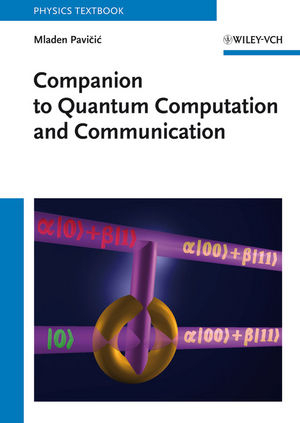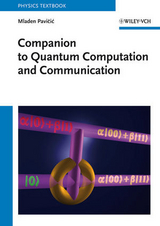Companion to Quantum Computation and Communication
Wiley-VCH (Verlag)
978-3-527-40848-1 (ISBN)
- Titel ist leider vergriffen;
keine Neuauflage - Artikel merken
Diese Einführung in die Quanteninformation und das Quantenrechnen beschäftigt sich umfassend mit diesem schnell wachsenden Fachgebiet und erläutert alles Wissenswerte, ohne sich in mathematische Herleitungen zu verlieren.
Mladen Pavicic is a full physics professor at the University of Zagreb, Croatia. He stayed for more than five years in Germany (Humboldt University and Technical University of Berlin, University of Cologne), in the States (University of Maryland Baltimore County), in Austria (Atom Institute) and others. His research focuses on quantum information. Professor Pavicic is an Alexander von Humboldt and a Senior Fulbright fellow. He has been the head of five successive federal projects since 1996. He is author of the book `Quantum Computation and Quantum Communication? and of over 50 scientific articles in international peer reviewed journals.
1 Making Computation Faster and Communication Secure: Quantum Solution
1.1 Turing Machine: a Real Machine or . . .
1.2 . . . a Mathematical Procedure
1.3 Faster SuperTuring Computation
1.4 Digital Computers Do not Run on Logic
1.5 Speeding up Computation: Classical Analog Computation . . .
1.6 . . . versus Quantum Physical Computation
1.7 Complexity Limits: Exponential Time
1.8 Energy Limits . . .
1.9 . . . and Reversible Gates
1.10 Ultimate Efficiency: Quantum Computers and Qubits
1.11 Combining andMeasuringQubits: QuantumSuperposition?Qubit Primer
1.15 Generating Qubits: Sources of Photons?Polarization Primer
1.16 Correlating Unpolarized Qubits: Quantum Entanglement
1.17 Separating and Transforming Entanglements: Bell States at a Beam Splitter
1.18 Manipulating and Verifying Entanglements: Superdense Coding
1.19 Copying Qubits? No. Teleporting Qubits!
1.20 Unperformed Measurements Have no Values: KochenSpecker Sets
1.21 Controlling Qubits: Quantum Gates and Circuits
1.22 Self-Sustaining Qubits: Quantum Error Correction
1.23 Flying Qubits Connecting Quantum Chips and Computers: Quantum Repeaters
1.24 Why Classical Cryptography Cannot Keep Secrets for Long . . .
1.25 . . . and why Quantum Cryptography Can?
1.25.1 Entanglement in Action: Deterministic Communication
1.25.2 NoCloning in Action: Probabilistic BB84 Protocol
1.26 WhyThereCanBe noQuantumEavesdroppers? Unconditional Security
2 Quantum Computation and Communication Hardware
2.1 Technological Candidates for Quantum Computation Implementation
2.2 All-Optical Scalable Quantum Computation
2.2.1 Probabilistic Parity Check Gate with a Quantum Encoder
2.2.2 Destructive CNOT Gate
2.2.3 Nondestructive Probabilistic Full CNOT Gate
2.2.4 The Teleportation Trick
2.2.5 Scalable Computation
2.3 Trapped Ions
2.4 Nuclear Magnetic Resonance
2.5 SiliconBased Nuclear Spins?Kane?s Computer
2.6 Quantum Dots
2.6.1 EnergyLevel Design; Quantum Dots in a Microcavity
2.6.2 Atom-Cavity Interaction between Levels |0> and |1>
2.6.3 Laser-Atom Interaction between |0> and |1>
2.6.4 Atom-Cavity and Laser-Atom Interactions between |0> and |2>
2.6.5 Implementation of a CNOT gate
2.6.6 Reading out the Results; Perspectives
2.6.7 Spinlevel design; array of coupled quantum dots
2.7 Superconducting Devices
2.7.1 Josephson Junction
2.7.2 Josephson Junction Circuit and Hamiltonian
2.7.3 Josephson Junction Cooper-Pair Box
2.7.4 Superconducting Quantum Interference Device?SQUID
2.7.5 Cooper Pairs
2.7.6 Quantum Gates for Single Qubits
2.7.7 Quantum Gates for Two Qubits?CNOT Gate
2.7.8 Reading out the results
3 Melting Theory with Implementation
3.1 Quantum Network
3.1.1 One-Atom Laser and Atom-Cavity Coupling
3.1.2 Single Photons on Demand
3.1.3 Dark States
3.1.4 Quantum Repeaters Revisited
3.2 Quantum-Classical Coupling: Interaction-Free Computation
3.3 Quantum Algorithms: Quantum or Classical Problems?
3.3.1 Are there Universal Quantum Algorithms?
3.3.2 Quantum Coin?Deutsch?s Algorithm
3.3.3 Deutsch-Jozsa and Bernstein-Vazirani Algorithms
3.3.4 Shor?s Algorithm
3.3.5 Quantum Simulators
4 Beyond Standard Qubit Computation
4.1 Persistent Entanglement
4.2 One-Way Computing and Cluster States
4.2.1 Dumping Reversibility and Unitarity?
4.2.2 Irreversible Measurement Setup
4.2.3 Reversibility and Unitarity Revisited
4.3 Continuous Variables
4.3.1 Continuous Entanglement
4.3.2 Second-Order (One-Photon) vs. Fourth-Order (Two-Photon) Interference
4.3.3 Qubits with Continuous Spatial Degree of Freedom
4.3.4 Universal Quantum Computation with Continuous-Variable Cluster States
5 Epilogue?Hybrid Systems
| Erscheint lt. Verlag | 30.4.2013 |
|---|---|
| Reihe/Serie | Physics Textbook |
| Verlagsort | Weinheim |
| Sprache | englisch |
| Maße | 170 x 240 mm |
| Gewicht | 680 g |
| Themenwelt | Mathematik / Informatik ► Informatik ► Theorie / Studium |
| Naturwissenschaften ► Physik / Astronomie ► Quantenphysik | |
| Naturwissenschaften ► Physik / Astronomie ► Theoretische Physik | |
| Technik ► Elektrotechnik / Energietechnik | |
| Schlagworte | Computer Science • Computer Science Special Topics • Electrical & Electronics Engineering • Electrical & Electronics Engineering • Elektrotechnik u. Elektronik • Informatik • Physics • Physik • Quantencomputer • Quantenphysik • Quantenphysik u. Feldtheorie • Quantum Computing • Quantum Physics & Field Theory • Quantum Physics & Field Theory • Spezialthemen Informatik |
| ISBN-10 | 3-527-40848-7 / 3527408487 |
| ISBN-13 | 978-3-527-40848-1 / 9783527408481 |
| Zustand | Neuware |
| Haben Sie eine Frage zum Produkt? |
aus dem Bereich




